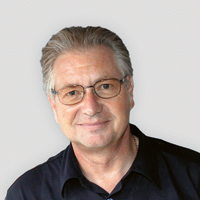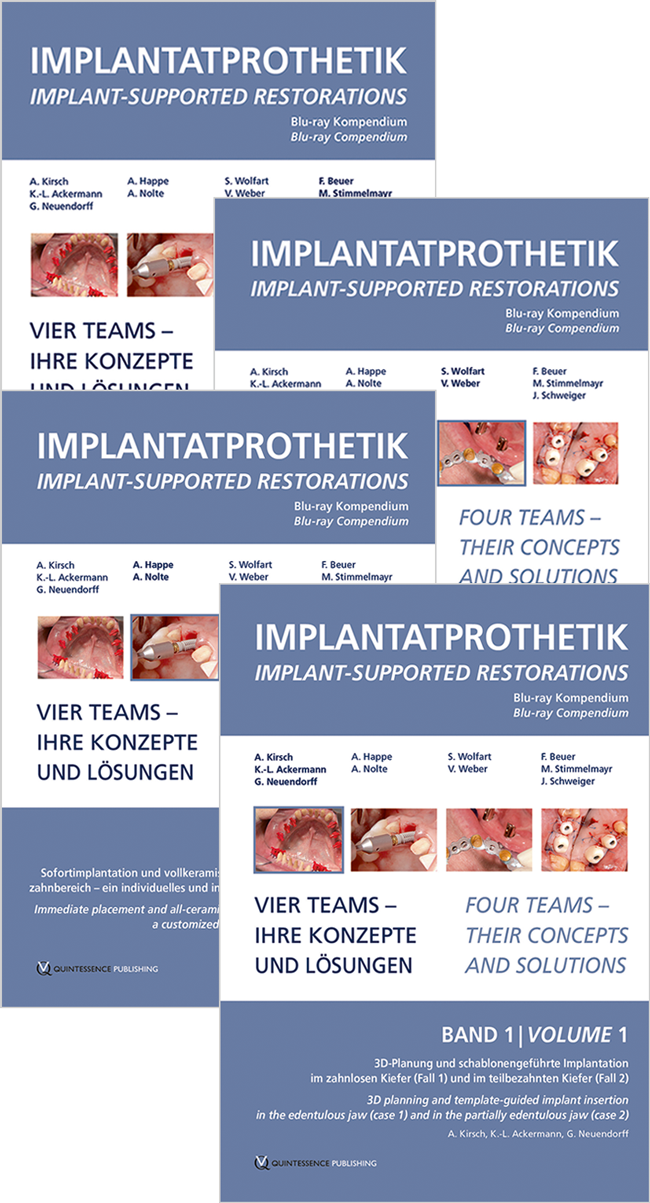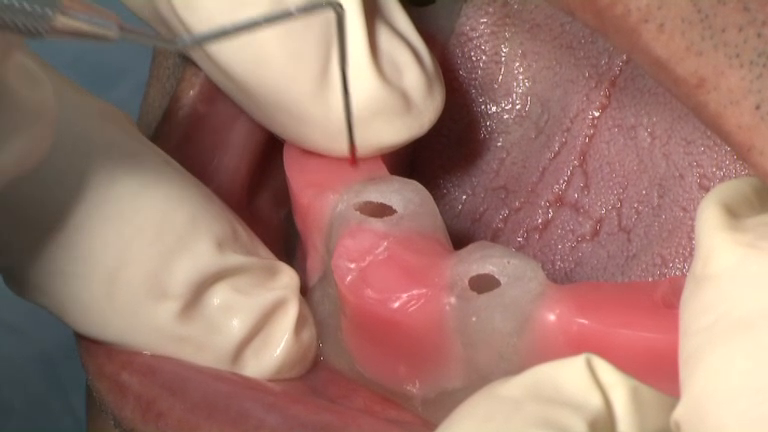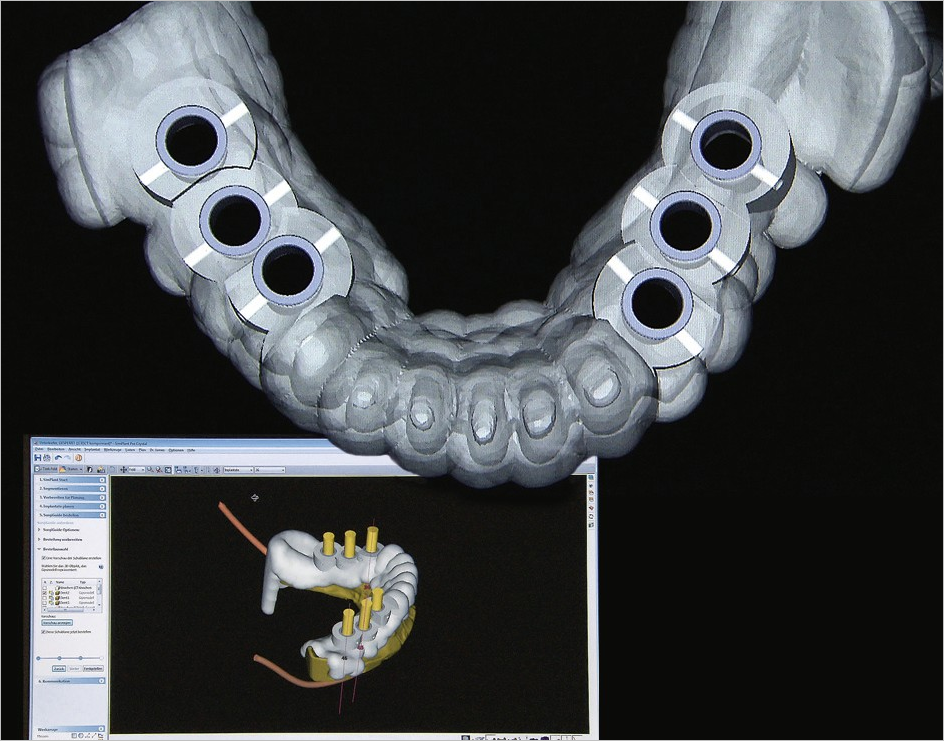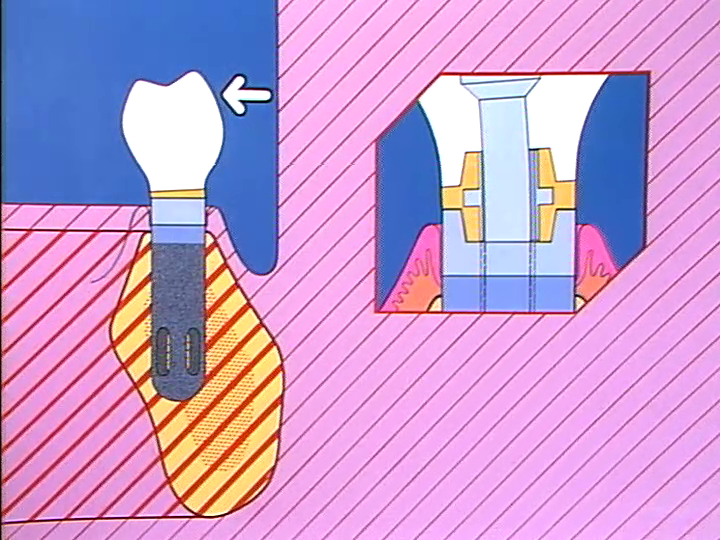Implantologie, 4/2017
Seiten: 385-388, Sprache: DeutschTetsch, Peter / Tetsch, Jan / Strub, Jörg R. / Buser, Daniel / Kirsch, AxelWie kamen Sie zur Implantologie?Zur Feier des 25-jahrigen Jubiläums der IMPLANTOLOGIE haben wir Prof. Daniel Buser, Dr. A. Kirsch, Prof. Jörg R. Strub sowie Prof. Peter Tetsch und Dr. Jan Tetsch (als Vater-Sohn-Gespann) - alle erfahrene Spezialisten auf dem Gebiet der Implantologie - gefragt, wie Sie zur Implantologie gekommen sind, was sich im Laufe der Zeit geändert hat und wo die Reise ihrer Meinung nach hingeht.
Implantologie, 3/2008
Seiten: 317-330, Sprache: DeutschKeweloh, Martin / Kirsch, Axel / Ackermann, Karl-Ludwig / Steckeler, Stefan / Fröschl, ThomasDie Versorgung stark resorbierter Unterkiefer mit Resthöhen von weniger als 6 mm ist eine große Herausforderung. Im Folgenden wird anhand eines Fallbeispiels eine Modifikation des von Marx beschriebenen Tent-Pole-Verfahrens vorgestellt. Dabei wird der Unterkiefer über einen submentalen Zugang dargestellt und kranial vom Kieferkamm bis zum Retromolarbereich ein tunnelförmiger Raum erzeugt. Nach interforaminaler Insertion von vier bis sechs Implantaten wird ein Gemisch aus Beckenkammknochen und Knochenersatzmaterial um die Implantate herum und über den distalen Kieferkamm eingebracht und anterior mit einem gedehnten Weichteillappen abgedeckt. Bereits zwei Wochen nach dem Eingriff kann das geschützt einheilende Augmentat mit einer temporären Prothese belastet werden. Bisher wurden sechs Patienten mit dieser Methode behandelt. Bei fünf dieser Patienten wurde die Augmentathöhe mit Hilfe von Panoramaschichtaufnahmen über einen Zeitraum von bis zu viereinhalb Jahren quantitativ nachuntersucht. Alle Patienten sind bei einem Follow-up von bis zu siebeneinhalb Jahren erfolgreich mit Teleskopprothesen versorgt worden. Die Augmentate blieben weitgehend stabil; Implantatverluste waren nicht zu verzeichnen.
Schlagwörter: Unterkieferresorption, Implantate, extraoraler Zugang, Tent-Pole-Verfahren, GBR, Panoramaschichtaufnahme, Totalprothese, Doppelkronen
International Journal of Periodontics & Restorative Dentistry, 1/2001
Seiten: 49-59, Sprache: EnglischHutmacher, Dietmar W. / Kirsch, Axel / Ackermann, Karl L. / Hürzeler, Markus B.Tissue engineering is an emerging discipline that applies engineering principles to create devices for the study, restoration, modification, and assembly of functional tissues and organs from native or synthetic sources. In the field of guided bone regeneration (GBR), cellular matter engineering has been applied, more or less successfully, to the development of biodegradable and bioresorbable devices with chemical, physical, or mechanical properties, structure, or form that permit active tissue integration with desirable cell types and tissue components. The employment of synthetic and naturally occurring polymers as well as sophisticated manufacturing technologies allow the tissue engineering of matrix configurations so that the biophysical limitations of mass transfer can be satisfied. The configuration of such a hybrid matrix can also be manipulated to vary the surface area available for cell attachment, as well as to optimize the exposure of the attached cells to nutrients. A biodegradable and bioresorbable device made of synthetic and natural polymers was engineered specifically for GBR procedures. The degradation and resorption kinetics as well as the mechanical properties give the device the potential to function as a carrier for bone growth factors. This innovative device was applied as a GBR membrane in a clinical investigation inseven patients.
The International Journal of Oral & Maxillofacial Implants, 2/2000
Seiten: 209-218, Sprache: EnglischWatanabe, Fumihiko / Uno, Ichiyo / Hata, Yoshiaki / Neuendorff, Gerhard / Kirsch, AxelFour types of implant superstructures were screwed onto implant bodies, and the strains created around the implant bodies were compared and analyzed within the IMZ Implant System. Three IMZ implants were embedded in the center of a polyurethane block (30 x 40 x 30 mm), and a total of 16 superstructures was fabricated by 4 methods: 1-piece cast, 1-piece cast/split soldering, soldering, and passive fit. Six strain gauges were placed on the surface of the block 1 mm apart. Three embedded implants were numbered, and a fixed partial denture was placed on these implants and screwed by a torque wrench using 14.5 Ncm torque. This procedure was repeated 7 times for each fixed partial denture, and each created strain was measured when the last screw was tightened. In all fixed partial dentures, strains were produced around the implant bodies when screws retaining the prosthesis were tightened, and the strain was relieved with unscrewing. The magnitude of strain was greater with the 1-piece cast method or the section/solder method than with the soldering and passive-fit methods. Of the 2 soldering methods, when the screw on the middle implant was tightened before those on the terminal 2 implants, the magnitude of strain was lower with the soldering method than with the 1-piece cast/split soldering method. When the order of screw tightening was changed, there were significant differences in the magnitude of strain at each gauge with the soldering method. With the passive-fit method, no differences in the magnitude of strain attributable to the order of screw tightening could be detected. The magnitude of strain produced around a screw-retained implant prosthesis was significantly lower with the passive-fit method when compared to the other 3 fabricating methods. Furthermore, the implants prepared by the passive-fit method were not affected by the order of screw tightening.
Schlagwörter: implant prosthesis, passive fit, strain gauge, stress distribution, tightening screw
The International Journal of Oral & Maxillofacial Implants, 6/1999
Seiten: 819-823, Sprache: EnglischFugazzotto, Paul A. / Kirsch, Axel / Ackermann, Karl-Ludwig / Neuendorff, GerhardNumerous problems have been reported following various therapies used to attach natural teeth to implants beneath a fixed prosthesis. This study documents the results of 843 consecutive patients treated with 1,206 natural tooth/implant-supported prostheses utilizing 3,096 screw-fixed attachments. After 3 to 14 years in function, only 9 intrusion problems were noted. All problems were associated with fractured or lost screws. This report demonstrates the efficacy of such a treatment approach when a natural tooth/implant-supported fixed prosthesis is contemplated.
Schlagwörter: implant-tooth support, intrusion, screw-fixed attachments
Quintessenz Zahnmedizin, 10/1999
Oralchirurgie / Orale MedizinSprache: DeutschKirsch, Axel / Neuendorff, Gerhard / Ackermann, Karl L. / Nagel, Rainer / Dürr, WalterZiel der Neuentwicklung des Camlog-Systems war es, basierend auf 25 Jahren implantatprothetischer Erfahrung die bekannten designbedingten mechanischen Probleme, die Unzulänglichkeiten in der Handhabung sowie die ästhetischen und funktionellen Einschränkungen der derzeit auf dem Markt befindlichen Systeme zu überwinden. Die kritische Auseinandersetzung mit eigenen und alieno loco gemachten Erfahrungen haben ab 1995 zur Entwicklung einer neuen Hardware-Generation geführt, deren Herzstück eine innovative Implantataufbauverbindung ist. Die biomechanische Grundkonzeption der Camlog- Aufbauverbindung gestattet erstmals sicher und zuverlässig die Möglichkeit der Zahn-für-Zahn-Restauration auch im Seitenzahnbereich des Ober- und Unterkiefers mit einer vorhersehbaren Langzeitprognose. Die nach apikal abgestufte röhrenförmige Extension der Implantataufbauten erlaubt quasi blind eine einfache und schnelle Orientierung in die Längsachse des Implantates: Nach einer leichten Rotationsbewegung rastet der Aufbau sichtbar und spürbar in seine Endposition ein. Das Tube-in-tube-Design der Camlog-Verbindung ist mechanisch sehr stabil und absolut (0°) rotationsgesichert. Die Konstruktionsmerkmale der Camlog-Verbindung führen zu annähernd 100 % höheren Werten bei dem statischen Festigkeitstest und zu über 60 % höheren Werten im Dauerwechselbelastungstest gegenüber den von der FDA geforderten Mindestwerten. Das Camlog-System sowie seine Komponenten werden beschrieben, die klinische Anwendung für verschiedene Indikationen wird anhand von vier Fallbeispielen demonstriert, und erste Ergebnisse einer prospektiven Studie zu Knochenabbaurate, Erfolgsquote und Komplikationsrate nach 3jähriger Beobachtungszeit von 1.764 Implantaten werden vorgestellt.
Schlagwörter: Einzelkronenrestauration, Implantataufbauverbindung, Implantatästhetik, Knochenabbaurate
Quintessence International, 6/1998
Sprache: EnglischKirsch, Axel / Ackermann, Karl L. / Hurzeler, Markus B. / Durr, Walter / Hutmacher, DietmarClinical applications of the principles of guided bone regeneration
The International Journal of Oral & Maxillofacial Implants, 4/1996
Seiten: 466-475, Sprache: EnglischHürzeler, Markus B. / Kirsch, Axel / Ackermann, Karl-Ludwig / Quiñones, Carlos R.The aim of this investigation was to determine the long-term clinical outcome and predictability of the maxillary sinus augmentation procedure utilizing a variety of bone augmentation materials. The augmentation materials evaluated were a xenograft alone (Bio-Oss), an alloplast alone (Interpore), a xenograft-alloplast combination (Bio-Oss mixed with Interpore in a 1:1 ratio), an alloplast (Interpore) mixed with autogenous bone from the iliac crest (in a 1:3 ratio), and an alloplast (Interpore) mixed with autogenous bone from the chin (in a 1:1 ratio). A total of 340 plasma-sprayed cylinder implants (IMZ) were placed, either simultaneously with the sinus augmentation procedure (235 implants), or 6 months after the procedure (105 implants) in 133 patients with insufficient bone volume in the posterior maxilla. The implants were restored with a total of 151 fixed detachable ceramometal prostheses and evaluated up to a 5-year period. Clinical evaluations included yearly assessments of peri-implant inflammation, implant mobility, and clinical attachment levels. Radiographs were also taken prior to sinus augmentation surgery, at abutment connection, at completion of the restoration, and thereafter at yearly intervals. All of the implants placed into the augmented sinuses achieved osseointegration. Only four implants (1.2%) failed to maintain osseointegration after prosthesis placement, yielding an implant survival rate of 98.8% during the entire course of the study. Of the 340 implants, 307 (90.3%) were considered successful according to the success criteria used. Gender, implant length and location, remaining bone height, and type of bone augmentation material had no effect on implant success. None of the 151 prostheses was lost during the observation period. The results of this study support the long-term clinical predictability of maxillary sinus augmentation procedures for the rehabilitation of the edentulous posterior maxilla with implant supported prostheses.
Schlagwörter: dental implant, implantology, oral surgery, prosthodontics, sinus augmentation
The International Journal of Oral & Maxillofacial Implants, 4/1987
Seiten: 203-216, Sprache: EnglischBabbush, Charles A. / Kirsch, Axel / Mentag, Paul J. / Hill, BrianThe Intramobile Cylinder (IMZ) Two-Stage Osteointegrated Implant System is unique. The IMZ Implant System incorporates a Delrin, intramobile element (IME) which simulates the periodontal ligament of the natural tooth unit. This shock-absorbing element distributes stress and functional load in a physiological manner so that the semi-edentulous patient may be reconstructed by splinting to the adjacent natural teeth. This article will discuss the IMZ Implant System, its surgical insertion, prosthetic reconstruction, and the rationale and concepts of the intramobile element. It will further review the clinical findings of 3,436 implants placed during the past 10 years in West Germany primarily, followed by the past 2 years experience in North America.



